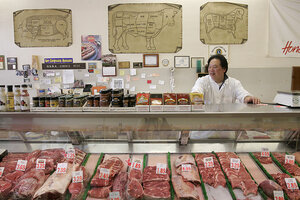Can meat and sustainability go together?
Raising eggs, meat, and dairy on an industrial scale tends to be very resource-intensive. However, livestock are integral to the nutritional well-being and livelihood of millions of people around the world.

Co-owner Mathew Lee awaits customers behind the counter at Save More Meats in Pacifica, Calif. in 2008.
Marcio Jose Sanchez/AP/File
Livestock production has gained a less-than-desirable environmental reputation as raising eggs, meat, and dairy on an industrial scale tends to be very resource-intensive. However, livestock are integral to the nutritional well-being and livelihood of millions of people around the world. There is now an unprecedented demand for meat, and global meat production is expected to increase by 19 percent from 2014 to 2023. This has led the U.N. Food and Agriculture Organization (FAO) to release Tackling Climate Change Through Livestock, a report encouraging broader conversations about reducing livestock emissions and implementing alternatives.
The FAO has developed the Global Livestock Environment Assessment Model (GLEAM), which produces estimates of the greenhouse gas (GHG) emissions of the livestock industry by livestock type, farming system, and location using data from the 2006 IPCC Guidelines for National Greenhouse Gas Inventories.
Currently, the global population of ruminant animals (cattle, sheep, and goats) is approximately 3.6 million head, just under half the current world population, according to the GLEAM. It also estimates that this livestock population contributes 14.5 percent of GHG emissions induced by humans. Cattle, both beef and dairy, are by far the largest contributors, representing 65 percent of emissions from the livestock sector. Feed production and processing (49 percent) and methane from fermentation (39 percent) are the main contributors to emissions along the supply chain.
However, the FAO have also outlined that the livestock sector provides livelihoods to an estimated one billion people and demand for protein is set to continue to spike in developing countries, with 83 percent of the extra meat consumed in 2013 coming from these regions.
So, what can be done to drive down growing emissions while demand for meat production rises?
The FAO argues that to decrease emission levels, the industry must improve practices such as feeding processes, animal husbandry, and herd management rather than changing production systems. They also recommend reducing the demand and supply of meat products and the current intensity of production. This could have a mitigation potential of between 14 to 41 percent depending on the species of livestock, says the FAO.
To put this plan into action, they recommend that policymakers and activists work to raise awareness and implement extensions. Appropriate frameworks, both institutional and incentive, should also be implemented to assist farmers in making the necessary changes to their business models and processes to reduce GHG emissions.
The FAO suggests that there is a great potential to significantly reduce the GHG emissions of the livestock and meat industries and that solutions are within reach.
Airlie grew up on a livestock and cropping farm in Australia and is currently completing a Masters in Food and Resource Economics at the University of British Columbia in Vancouver.

